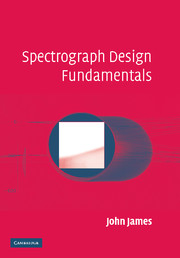Book contents
- Frontmatter
- Contents
- Preface
- Acknowledgements
- 1 A brief history of spectroscopy
- 2 The relevant regions of the electromagnetic spectrum
- 3 Geometrical optics
- 4 Optical aberrations
- 5 Fourier transforms: a brief revision
- 6 Physical optics and diffraction
- 7 The prism spectrograph
- 8 The plane grating spectrograph
- 9 The concave grating spectrograph
- 10 The interference spectrograph
- 11 The multiplex spectrometer
- 12 Detectors
- 13 Auxiliary optics
- 14 Optical design
- 15 Mechanical design and construction
- 16 Calibration
- 17 The alignment of a spectrograph
- Appendix 1 Optical aberrations
- Appendix 2 Wavelengths of spectral lines for calibration
- Appendix 3 The evolution of a Fabry–Perot interference spectrograph
- Appendix 4 The common calibration curve in silver halide spectrophotometry
- Bibliography
- Index
4 - Optical aberrations
Published online by Cambridge University Press: 02 September 2009
- Frontmatter
- Contents
- Preface
- Acknowledgements
- 1 A brief history of spectroscopy
- 2 The relevant regions of the electromagnetic spectrum
- 3 Geometrical optics
- 4 Optical aberrations
- 5 Fourier transforms: a brief revision
- 6 Physical optics and diffraction
- 7 The prism spectrograph
- 8 The plane grating spectrograph
- 9 The concave grating spectrograph
- 10 The interference spectrograph
- 11 The multiplex spectrometer
- 12 Detectors
- 13 Auxiliary optics
- 14 Optical design
- 15 Mechanical design and construction
- 16 Calibration
- 17 The alignment of a spectrograph
- Appendix 1 Optical aberrations
- Appendix 2 Wavelengths of spectral lines for calibration
- Appendix 3 The evolution of a Fabry–Perot interference spectrograph
- Appendix 4 The common calibration curve in silver halide spectrophotometry
- Bibliography
- Index
Summary
When parallel rays pass through a centred, image-forming optical system infinitesimally far from the axis, they arrive at the corresponding paraxial image point. Its position is computed using the Gaussian optical equations.
It is an unfortunate fact that in general parallel rays coming through the system at the outer parts of the apertures or pupils do not arrive at the same image point as the paraxial rays. They arrive in the vicinity of the paraxial image point and their separations from it define the aberrations of the system. Rays which pass the edges of the pupils are called the marginal rays and the separation of these rays from the paraxial image point can be calculated using aberration theory.
In instrument design we arrange the various components of the system so that the aberrations are reduced to zero where possible and minimised where not. The whole theory is non-linear; the various causes of aberration interact with each other and the resulting complication is often deplorable. To ease the analysis we simplify things by treating each aberration as though the others were all absent.
Optical designers are sometimes eccentric and the routes to their designs are often highly individual and hard to follow. Conrady, for example, is regarded as the father of modern optical design but his notation is not to be recommended. In any case, for plain spectrograph optics we need only a small subset of the theory and this is laid out below in reasonably familiar language.
- Type
- Chapter
- Information
- Spectrograph Design Fundamentals , pp. 28 - 40Publisher: Cambridge University PressPrint publication year: 2007



